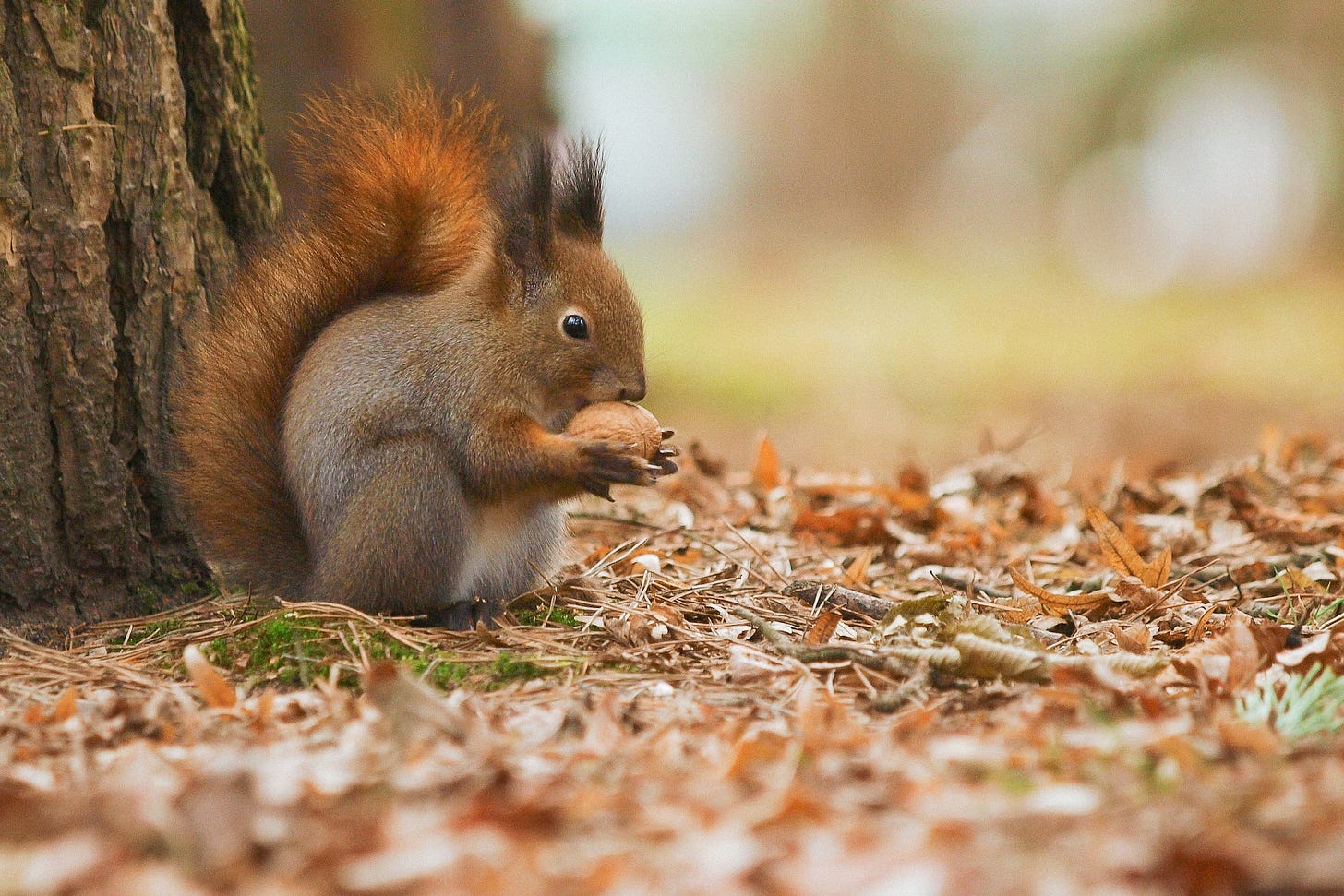Lessons from Squirrels
Observations on our "outdoor pets" and reclaiming a bit our wildness.
When I lived in Denver, I considered three special squirrels to be my “outdoor pets”. These were city squirrels that lived in our very urban backyard.
Brown, sleek and wily, I watched as they darted around our yard as if it were their own. And, of course, it was.
These Denver squirrels made a nest in our roof — with cotton pilfered from our patio chair cushions. They ate our tomatoes, stole our corn, and took big bites out of every single squash we grew.
Once, a squirrel hopped in the lettuce bed as I was weeding, looked me straight in the eye, wrapped its little arms around a giant leaf, and took a single bite out the middle. I swear it smiled as it stood there, waiting for my reaction.
They were so naughty and so cute. I loved them completely.
Over the years, I was able to build a relationship with these squirrels. I could identify each one, and we came to a truce with the garden. (It took two years, but they finally focused on eating 2-3 squash total and leaving the rest untouched.)
I suppose I got used to these squirrels that had adapted to the city, as I had. They would often leave slices of half eaten bread in our yard. They stole all sorts of cottons and fabrics for their nests. I rarely saw them gather anything that hadn’t been made or grown by a human.
The squirrels here are different.
Big and gray, with tails that rival those of a winter fox, these are not the squirrels I knew in the city. The squirrels I live with in Central Oregon are a bit more wild.
They keep their distance when I’m outside—hopefully trust will build over time—but I often watch them through our windows.
If the city squirrels had a bit of tough, no-nonsense, street-smart vibe, these wild squirrels are brave yet cautious. I once saw one skillfully somersault just out of reach from a hunting hawk.
After years of living with city squirrels, I feel somewhat awed when I now see one storing a pinecone for food, or gathering bunches of grass to prepare its winter nest.
This makes me ridiculously happy. Perhaps because it just seems so healthy.
No more cotton or white bread. Just the natural foods and materials that squirrels in the wild enjoy.
Like the squirrels, we humans adapt to our environments.
We use what’s around us to survive — for better or worse.
Yet, there’s a inner sense of alignment I feel when I see a squirrel carrying a pine cone versus a tortilla (yes, it’s happened). And I wonder if getting back to our own wild roots a bit more would feel more in alignment for us humans, too.
Living with the seasons, sourcing local and wild foods, knowing your land…every bit of rewilding we do on earth rewilds our spirits, as well.
As a spirit animal, squirrel is often said to carry the gift of preparation — gathering and storing sustenance throughout the summer and fall for the long winter ahead.
Perhaps in this way, the squirrels all around ask us to look at what it is we’re storing. Yes, preparation is good medicine. Filling our pantries can fill our souls. (And I think most of us are a bit more hyper aware of the need for preparation after the pandemic.)
Yet, let’s ask ourselves — what are we gathering? Is it food, materials, and even ideas that nourish us? Or have we been programmed to fill up on that which does not truly align with our souls?
We are currently in a potent time for releasing the old to make way for the new, with the freshness of spring inspiring us to clean out our homes, bodies, and minds. How are you preparing for the season ahead?
P.S. If you’re interested in learning more about how to work with the spirit animals in your life, I have a fabulous resource for you here.
With love,
Juniper





Oh alignment... really feeling the blessings of squirrel medicine here, and love the ‘pine cone’ vs ‘tortilla’ reflection - I noticed even in just reading it I felt happier and less damaging as a human... 🤍🐿️